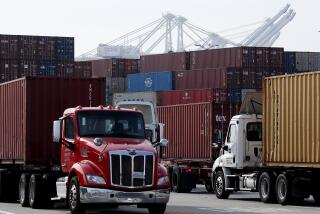German Firm Plans to Cut Into Truck Market : Daimler-Benz Gets Rolling in U.S.
- Share via
HAMPTON, Va. — West Germany’s Daimler-Benz AG is assembling a new weapon here in its campaign to take a bigger piece of the U.S. medium-truck market.
It is the LPS 1525, a medium-duty, cab-over-engine, diesel-powered truck that drives with the ease of a manual transmission car.
Daimler-Benz, better known in the United States for its Mercedes-Benz passenger cars, wants to use the LPS 1525 to help boost its current 2.6% share of the domestic medium-truck market to about 7% by the end of the decade.
That gain would come at the expense of General Motors, International Harvester and Ford Motor, American companies that control about 90% of the domestic medium-truck market, Daimler-Benz officials said.
The remaining 10% of the U.S. medium-truck market is occupied by imports and a collection of foreign companies, such as Daimler-Benz, which have assembly bases in the United States.
“We can get paranoid about what the 10% is doing, or we can go after the larger group. . . . We have to eat into the local (U.S.) manufacturers’ market,” said Peter E. Rupp, president and chief executive of Portland, Ore.-based Freightliner Corp. and its Hampton-based subsidiary, Mercedes-Benz Truck Co.
Active Since 1980
Freightliner assembles heavy-duty trucks; Mercedes-Benz Truck has been assembling medium-duty trucks here since 1980.
Both companies are owned by Daimler-Benz, the world’s largest producer of big commercial trucks used in the construction, manufacturing and retail industries.
Rupp said he “would be happy” if Mercedes-Benz Truck could take at least a 1% share each from GM, Ford and Harvester. “It doesn’t really matter where it comes from as long as it comes out of that 90% group,” he said.
Success in that endeavor would put the West German company on solid ground in an increasingly important segment of the U.S. truck industry and would ensure the long-term future of the Mercedes-Benz Truck plant here, Daimler-Benz and U.S. truck industry analysts said.
Daimler-Benz “seems to be saying, ‘We’re for real. We’re here to stay. We have to make Hampton a much more impressive place,’ ” said James A. Mateyka, truck industry analyst with New York-based Booz-Allen & Hamilton Inc.
The new truck “implies a bigger role for Hampton” in Daimler-Benz’s U.S. plans, Mateyka said.
Small Investment
Daimler-Benz’s investment in Hampton is about $10 million, which seems paltry in comparison with the $300-million and $600-million plants found in the automobile industry.
But the medium- to heavy-truck industry is different. It is a low-volume industry that relies more on labor than automation. It essentially is an assembly industry that runs on parts made by other companies.
Both characteristics mean tooling and plant costs that are small in comparison with those found in the car industry.
Medium trucks are used mostly for urban and short-haul deliveries, say between Washington and Baltimore. Heavy trucks are long-distance runners, often carrying cargo from the East Coast to the West Coast at grueling, sustained highway speeds.
Trucks in both categories, which carry about 75% of the nation’s annual freight shipments, run primarily on diesel fuel.
They are expensive machines, with 1984 prices ranging from $22,000 to as much as $60,000 for tractors (cab and chassis) and up to $22,000 for trailers (the truck’s cargo section). This year’s prices so far are in line with last year’s, truck industry analysts say.
Parts From Brazil
The Mercedes-Benz Hampton plant, which employs about 170 people, has assembled 13,000 medium trucks since opening five years ago. Most of the parts came from Daimler-Benz’s Brazilian operations.
Mercedes-Benz Truck sales last year were $98.1 million, a 24.5% increase over its 1983 sales performance of $74.1 million. The company last year assembled 3,459 medium trucks, compared to 41,803 assembled by GM, 40,931 by Harvester, 40,915 by Ford and 5,084 medium trucks assembled by Mack Trucks, an American company that is 45% owned by French auto maker Renault.
Some U.S. competitors pointed to Mercedes-Benz Truck’s small production numbers with derision when told of Rupp’s grand plans to increase his share of their medium-class market.
“They’re nothing but pipsqueaks,” one Ford official said. “They are in there with a bunch of other little companies that have come nibbling at our shores.”
But Mateyka and other truck industry officials said that that kind of seeming arrogance could backfire on U.S. truck assemblers, just as it did on U.S. auto makers who once dismissed the Japanese as insignificant competitors.
Japanese Enter Market
And the Japanese, in fact, are entering the domestic medium-truck market. Some of them already are here. Hino Motors, Isuzu Motors, Mitsubishi Motors and Nissan Diesel Motor Co. are currently selling medium-duty trucks in this country. Hino is assembling trucks in Deerfield, Fla., and marketing them in five Southern states.
“It’s the bridgehead strategy,” Rupp said. “The Japanese are establishing themselves in one spot at first. But then they will move out. The Japanese will not pass up the largest truck market in the world, which is the United States,” Rupp said.
Daimler-Benz, the Japanese and other foreign manufacturers moving into the U.S. truck market are betting that the reign of the heavy-duty trucks is nearing an end. The big trucks, rolling on 18 wheels and often weighing more than 70,000 pounds fully loaded, consume too much fuel and cost too much money, the foreigners say.
The foreign strategy in the U.S. market is to offer medium-duty trucks “as more efficient alternatives” to the heavier models, particularly for short-distance hauling, according to Gerry Donohue, who has prepared a report on the truck industry for the National Automobile Dealers Assn.
Pricing Is Key
The success of that tactic will depend largely on the ability of the foreigners to underprice their U.S. competitors and one another, Donohue said.
That, in part, is why Daimler-Benz is counting on its new LPS 1525, which the company hopes to sell to customers in the beverage, dairy and newspaper industries, among others.






